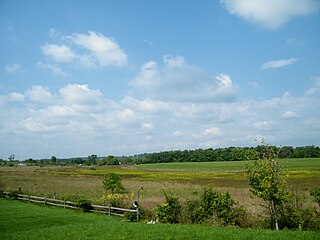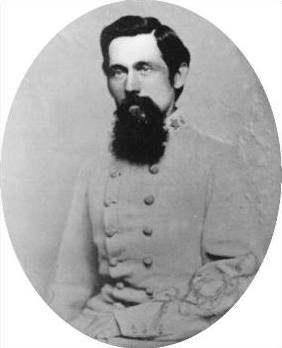
The Army of the Shenandoah was a field army of the Union Army active during the American Civil War. First organized as the Department of the Shenandoah in 1861 and then disbanded in early 1862, the army became most effective after its recreation on August 1, 1864 under the command of Philip Sheridan. The army's actions during the Valley campaigns of 1864 rendered the Shenandoah Valley of Virginia unable to produce foodstuffs for the Confederate States Army, a condition which would hasten the conclusion of the American Civil War.

The Battle of Cedar Creek, or Battle of Belle Grove, was fought on October 19, 1864, during the American Civil War. The fighting took place in the Shenandoah Valley of Northern Virginia, near Cedar Creek, Middletown, and the Valley Pike. During the morning, Lieutenant General Jubal Early appeared to have a victory for his Confederate army, as he captured over 1,000 prisoners and over 20 artillery pieces while forcing seven enemy infantry divisions to fall back. The Union army, led by Major General Philip Sheridan, rallied in late afternoon and drove away Early's men. In addition to recapturing all of their own artillery seized in the morning, Sheridan's forces captured most of Early's artillery and wagons.

The Battle of Monocacy was fought on July 9, 1864, about 6 miles (9.7 km) from Frederick, Maryland, as part of the Valley Campaigns of 1864 during the American Civil War. Confederate forces under Lt. Gen. Jubal A. Early defeated Union forces under Maj. Gen. Lew Wallace. The battle was part of Early's raid through the Shenandoah Valley and into Maryland in an attempt to divert Union forces from their siege of Gen. Robert E. Lee's army at Petersburg, Virginia.

The Third Battle of Winchester, also known as the Battle of Opequon or Battle of Opequon Creek, was an American Civil War battle fought near Winchester, Virginia, on September 19, 1864. Union Army Major General Philip Sheridan defeated Confederate Army Lieutenant General Jubal Early in one of the largest, bloodiest, and most important battles in the Shenandoah Valley. Among the 5,000 Union casualties were one general killed and three wounded. The casualty rate for the Confederates was high: about 4,000 of 15,500. Two Confederate generals were killed and four were wounded. Participants in the battle included two future presidents of the United States, two future governors of Virginia, a former vice president of the United States, and a colonel whose grandson, George S. Patton, became a famous general in World War II.

The Second Battle of Kernstown was fought on July 24, 1864, at Kernstown, Virginia, outside Winchester, Virginia, as part of the Valley Campaigns of 1864 in the American Civil War. The Confederate Army of the Valley under Lt. Gen. Jubal A. Early soundly defeated the Union Army of West Virginia under Brig. Gen. George Crook and drove it from the Shenandoah Valley back over the Potomac River into Maryland. As a result, Early was able to launch the Confederacy's last major raid into northern Union territory, attacking the Baltimore and Ohio Railroad in Maryland and West Virginia and burning Chambersburg, Pennsylvania, in retaliation for the burning of civilian houses and farms earlier in the campaign.

The Valley campaigns of 1864 began as operations initiated by Union Lieutenant General Ulysses S. Grant and resulting battles that took place in the Shenandoah Valley of Virginia during the American Civil War from May to October 1864. Some military historians divide this period into three separate campaigns. This article considers them together, as the campaigns interacted and built upon one another.
The Battle of Lynchburg was fought on June 17–18, 1864, two miles outside Lynchburg, Virginia, as part of the American Civil War. The Union Army of West Virginia, under Maj. Gen. David Hunter, attempted to capture the city but was repulsed by Confederate Lt. Gen. Jubal Anderson Early.

The Battle of Fisher's Hill was fought September 21–22, 1864, near Strasburg, Virginia, as part of the Valley Campaigns of 1864 during the American Civil War. Despite its strong defensive position, the Confederate army of Lt. Gen. Jubal Early was defeated by the Union Army of the Shenandoah, commanded by Maj. Gen. Philip Sheridan.
The Battle of Waynesboro was fought on March 2, 1865, at Waynesboro in Augusta County, Virginia, during the American Civil War. It was a complete victory for Brig. Gen. George Armstrong Custer and the final battle for Confederate Lt. Gen. Jubal Early, whose force was destroyed.

The Fluvanna Artillery was an artillery battery formed from citizens of Fluvanna County, Virginia, during the American Civil War. It participated in the Antietam and Gettysburg Campaigns, as well as the Shenandoah Valley Campaigns of 1864 under Confederate Major General Jubal Early. The Fluvanna Artillery began as two separate batteries raised in 1861.

The eastern theater of the American Civil War consisted of the major military and naval operations in the states of Virginia, West Virginia, Maryland, and Pennsylvania, the national capital in Washington, D.C., and the coastal fortifications and seaports of North Carolina. The interior of the Carolinas were considered part of the western theater, and other coastal areas along the Atlantic Ocean were part of the lower seaboard theater.
The following Confederate States Army units and commanders fought in the American Civil War's Second Battle of Kernstown on July 24, 1864, in Kernstown, now part of the Virginia city of Winchester. The Union order of battle is shown separately.

The city of Winchester, Virginia, and the surrounding area, were the site of numerous battles during the American Civil War, as contending armies strove to control the lower Shenandoah Valley. Winchester changed hands more often than any other Confederate city.
The following engagements took place in the year 1864 during the American Civil War. The Union armies, under the command of U.S. Grant, launched multiple offenses in all theaters of the war, in an attempt to prevent Confederate forces from transferring troops from one army to another.

Gabriel Colvin Wharton was an American civil engineer and soldier who served as a general in the Confederate Army during the American Civil War. After the war he was a politician and later resumed his engineering work.

The 22nd Virginia Infantry Regiment was an infantry regiment from the western Virginia that served in the Confederate States Army during the American Civil War. Its commander was George S. Patton Sr., the grandfather of World War II General George S. Patton.

Jubal Anderson Early was an American lawyer, politician and military officer who served in the Confederate States Army during the Civil War. Trained at the United States Military Academy, Early resigned his United States Army commission after the Second Seminole War and his Virginia military commission after the Mexican–American War, in both cases to practice law and participate in politics. Accepting a Virginia and later Confederate military commission as the American Civil War began, Early fought in the Eastern Theater throughout the conflict. He commanded a division under Generals Stonewall Jackson and Richard S. Ewell, and later commanded a corps.

The 45th Virginia Infantry Regiment was an infantry regiment raised in the Commonwealth of Virginia for service in the Confederate States Army during the American Civil War. It fought mostly in the mountainous area that today encompasses the border regions of Virginia and West Virginia, and was part of Jubal Early's Army of the Valley during the Valley Campaigns of 1864.

Rude's Hill is a 981-foot hill just outside of the town of Mt. Jackson in Shenandoah County, Virginia, United States, primarily known because it was a strategically placed elevation on which many Civil War events occurred. It was named after the Danish Lutheran minister Anders Rudolph Rude, who arrived in the US in 1836 and married the widow of the Steenbergen plantation. They inhabited a house on the hill called "Locust Grove" which dates to 1792, according to county records. As of July 2014 when the property was for sale, "Locust Grove" was in severely neglected condition with several ungainly exterior modifications over the years, but was still standing.

The 23rd Virginia Infantry Battalion, often called "Derrick's Battalion", was an infantry battalion in the Confederate Army during the American Civil War. It fought mostly in western Virginia and the Shenandoah Valley, and was usually part of a brigade commanded by John Echols or George S. Patton. By 1864, the brigade was usually part of a division commanded by Major General John C. Breckinridge or Brigadier General Gabriel C. Wharton.













